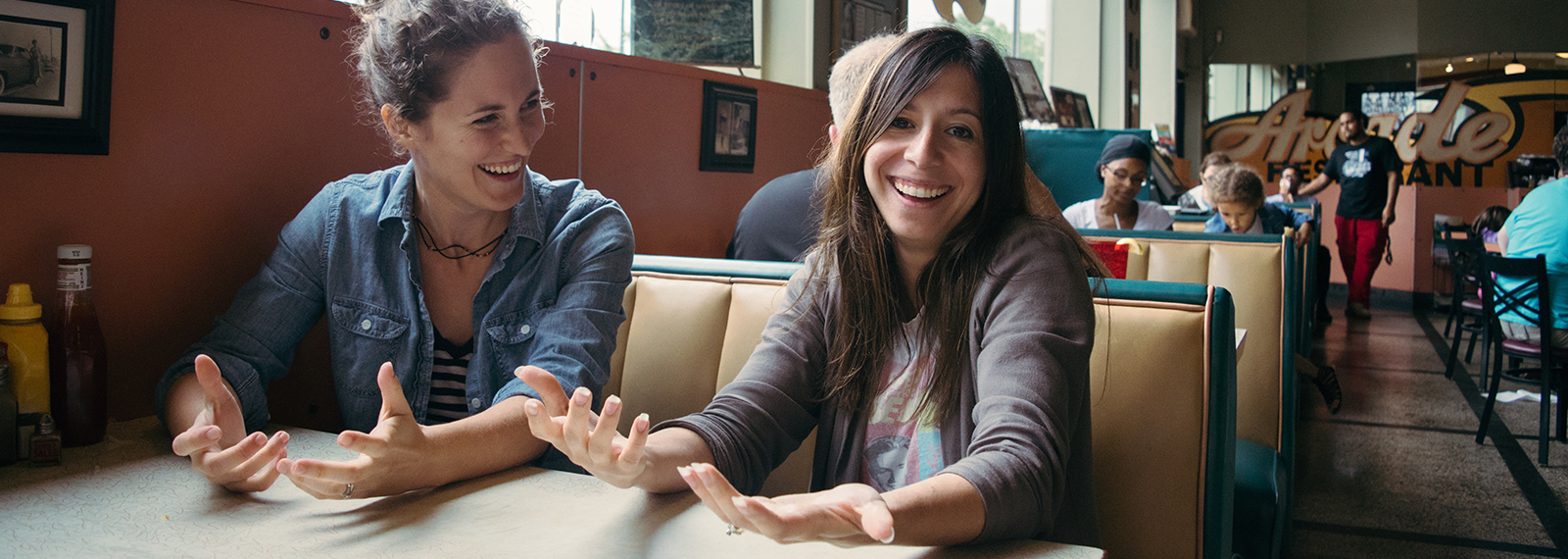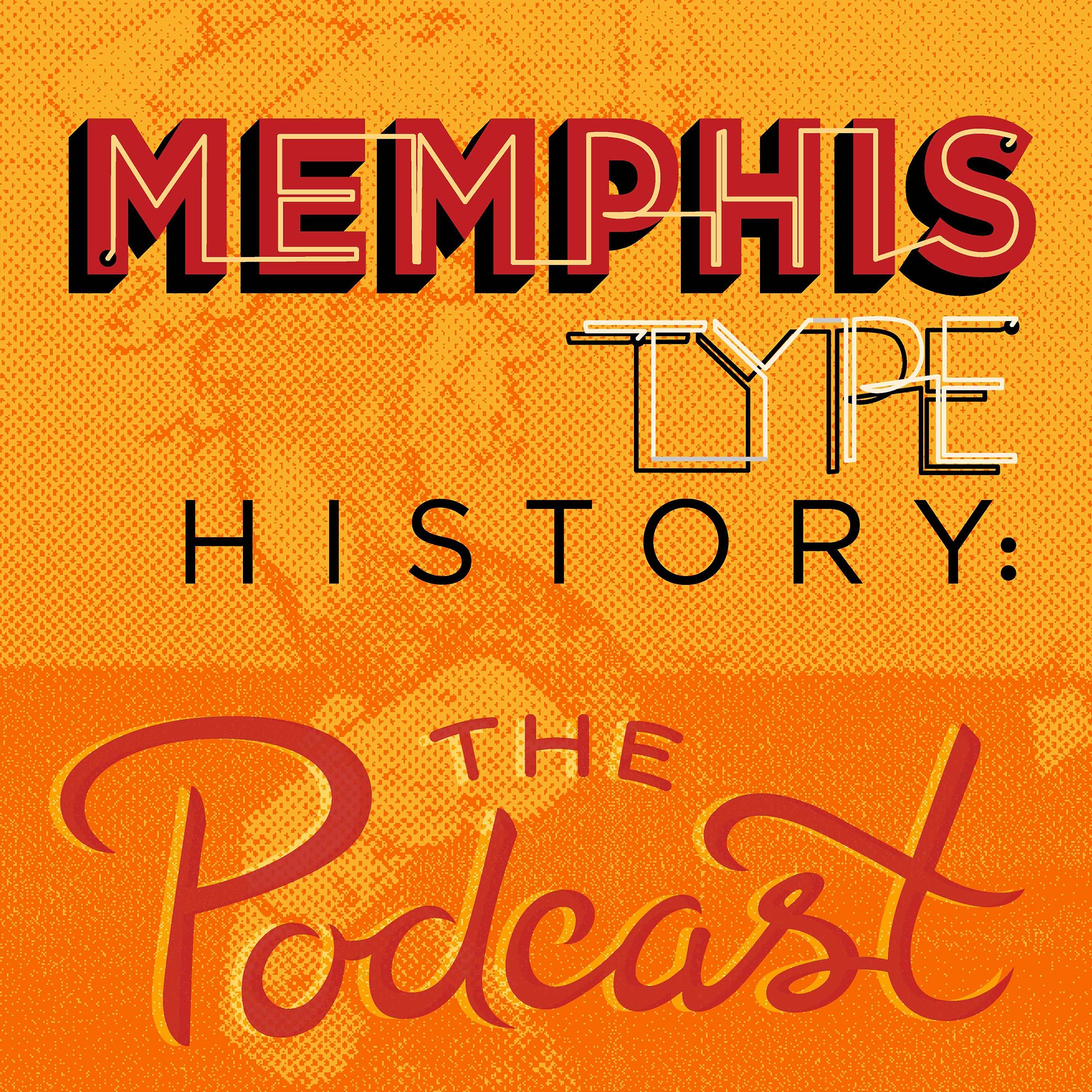Episodes

Monday Mar 19, 2018
Finding A Place in History with Julie Mccullough
Monday Mar 19, 2018
Monday Mar 19, 2018
Support this show via Patreon and get bonus content like our weekly blooper reel, digital wallpaper featuring Rebecca's artwork, t-shirts, signed books, and more!
In this episode of Memphis Type History: The Podcast, Caitlin chats with Julie McCullough of This Place in History, an Instagram feed we are excited to introduce you to. She typically features Memphis homes that are on the National Historic Registry, but you can find a few other types of historical nuggets on there from time to time.
Julie was motivated to start her American history inspired Instagram feed by a combination of things: seeing American Pickers, researching her great-great-grandfather's story from Memphis history, and her architect brother's line of work. We talk about East Buntyn her stories about her favorite Memphis street (spoiler alert, it's Front), and learn about charming historical Memphis homes.
Her police officer great-great-grandfather was shot in the line of duty on Front Street chasing a robber who stoles a dollar from a lady downtown. He was the first police death for the city.
Citizens of Memphis and the Memphis Police Department raised $2,000 for Parkinson's family after his death. Mrs. Parkinson used the money to buy land in Rosemark, TN (near Millington) and some of which still belongs to Julie's uncle. Julie thinks that since the family moved from Memphis to Rosemark, she ended up growing up in Millington.
Julie also shares her personal connections to Front Street, including a meaningful poem you can find there on the wall.
We also talk about the haunted Mollie Fontaine home, a favorite of Julie's and one you can visit for a drink or a good hang, and we touch on the Castle, which was Julie's very first post! A year later she posted the back of the Castle to celebrate her one-year Instagrammiversary.
Next we move onto her explorations of Victorian Village, where the "big guns" are, and her explorations of Holly Springs and beyond.
Listen to this one to get inspired about exploring history in your own way... maybe you'll get an idea for a project too! For all the photos, visit memphistypehistory.com/place
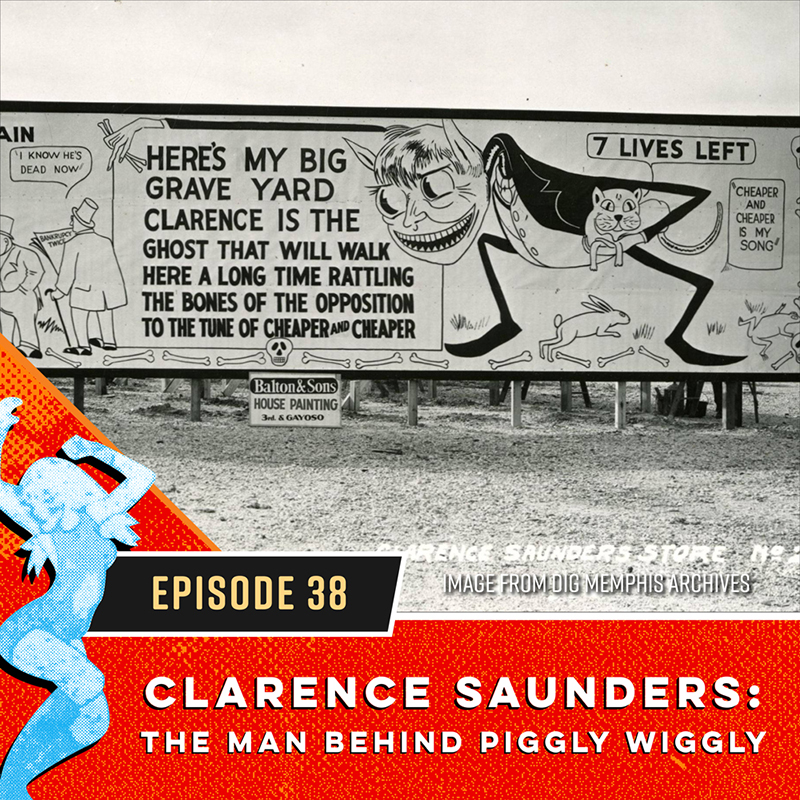
Sunday Mar 11, 2018
Clarence Saunders: The Man Behind Piggly Wiggly
Sunday Mar 11, 2018
Sunday Mar 11, 2018
In this episode of Memphis Type History: The Podcast, Rebecca meets with Caroline Mitchell Carrico at the Pink Palace to learn the insane story of the man who started Piggly Wiggly and the concept of grocery stores as we know them today. Hear how he lost it all in a gamble and then started the brilliant process back over.
Caroline Mitchell Carrico is the Supervisor of Exhibits and Graphic Services at the Memphis Pink Palace Museum. That means she researches and writes for the exhibits at the museum and also has a hand at the designs and installations of the exhibits as well. The massive project they have been working on is a complete redesign of the Pink Palace mansion. She’s been working on it for about 3 years now. You'll hear a little bit about what we can expect to find in the new layout.
Clarence Saunders, The Idea Man
Caroline gives a bit of Clarence Saunders job history. One of his first jobs was at a country store. You could buy anything you want to there. That’s where his start was and then through a series of job transitions, he landed as a Wholesale Drummer in Memphis. That’s the person who would go to all the different country stores and drum up business. He would convince the store owners to buy things and talk to them about how to improve their sales and improve their products. He developed enough ideas to decide he wanted to start up his own store. Carolynn talks about how he got together with a group of other store owners and started the United Stores company in town, where they did bulk purchasing. And she also talks about how the old country stores ran during this time.
The Birth of Piggly Wiggly
Clarence decided his store would be a cash-only store, and it would be a self-service grocery store. He set up the store so that you had to walk through the entire store through a serpentine path so you had to walk through every item. At first, people had to rent a shopping basket but then he quickly changed that so you could just borrow the shopping basket at the front and then the only time you interacted with the staff was at the end of the store when you were paying. At the time, a lot of grocery stores let you order your items and they would deliver it to you. But Clarence did away with that. People bought their items and took it home with them.
The store we’re talking about is Piggly Wiggly and Clarence Saunders made sure to patent the self service design. He actually got numerous patents, such as the store fixtures. There were arguments that there were already other self service style stores but Clarence was the first person to franchise it and turn it into a really big model that fundamentally changed the way that we shop.
Carolyn says Clarence Saunders did his own advertising as well and it was quite the advertisement. Here's an ad she provided for our reading enjoyment.
His store also essentially changed advertising for products as well because if people were now passing through goods and deciding which products to buy, businesses would need to make sure their product stood out from the others.
So Why the Name Piggly Wiggly?
One story is he was on a train and saw a bunch of pigs wiggling to get under a fence. Another story is during time he opened the store there was syndicated stories that ran in the newspaper called Uncle Wiggly’s bedtime tales and people speculate that it may have come from that.
It’s also possible that he just completely made up a funny name to be memorable but also possibly so to easily find people who were infringing on his copyright. He sued Hogglety Wogglety stores in Missouri and won because it was similar to his concept and name.
But Then He Lost it All
Saunders was the President of the corporation and he with the board of directors decided to list Piggly Wiggly stock at the New York Stock Exchange to raise capital. You'll have to listen to the episode to get the 101 on the stock market and how a sneaky plan backfired on Saunders, causing him to lose the company.
Did We Mention The Pink Palace Was Intended To Be His Mansion?
While the whole stock market incident happened, his mansion was still getting built (The Pink Palace). When he lost everything, the inside of the mansion wasn’t complete and he couldn’t live in it. He declared bankruptcy and lost the mansion and the estate which included Chickasaw Gardens and the Memphis lake. The plans for the Pink Palace was for it to be a millionaires playground. It was going to have a bowling alley, an indoor swimming pool, a Roman atrium, ballroom, a trout stream, a ridiculous amount of bedrooms. And as fascinating as this estate is, history also tells us that he cleared people off of this land so he could have it. Families were living on the property when he purchased it and they were forced to move and their houses were burnt to clear the land.
What ended up happening is the Garden Development Corporation from Kentucky purchased the land and mansion at the bankruptcy auction, they subdivided the neighborhood and created Chickasaw Gardens. At the time this was just outside the city. However, they didn’t know what to do with the mansion. They gave the property to the city with the expectation that it would become either a museum or art gallery or art conservancy and they wrote into the contract that it would only be for caucasian race because you know.. this was 1920. At the time there was already the Brooks Art Museum, The James Lee Art Academy was up and strong as an art conservancy, what the city didn’t have was a natural History museum. So they decided to turn the Pink Palace into the city’s Cultural and Natural History Museum.
And by the way, make sure to listen to the episode to hear additional fun facts about the mansion, such as how Clarence had a different name for it, its beginning days as a museum, and who the actual first people were to live inside it.
Clarence Saunders Stores was the name of his second grocery store. And then he was sued by Piggly Wiggly because they said his name was synonymous with Piggly Wiggly. The corporation lost the lawsuit and Saunders kept the rights to his name. So he named it Clarence Saunders Sole Owner of My Name Stores.
Clarence started building a second millionaire's playground further out East. It’s where the Lighterman Nature Center is today. Caroline thinks he called it Woodlawn. The guy was an avid golf player and built another golf course which was the longest golf course in the world at that time. He had built another lake and another house but this time he lost his business to the great depression and sold his estate to Bill Terry, the famous baseball player and manager for the Giants.
Things Are Better In Threes
Clarence started a third grocery store and named it Keedoozle. It stood for "Key Does it All." The concept was to make it an automated grocery store where you would go in and take your key (the big metal box-like thing) and you would stick it in the drawers of the items you wanted for it to punch your key and then you’d take your key to the check out line where a machine would read your key and a conveyor belt system would bring your items out. The idea was to not have to carry anything until the end. Unfortunately it had lots of problems since it was a bit ahead of its time.
For full show notes, visit memphistypehistory.com/saunders
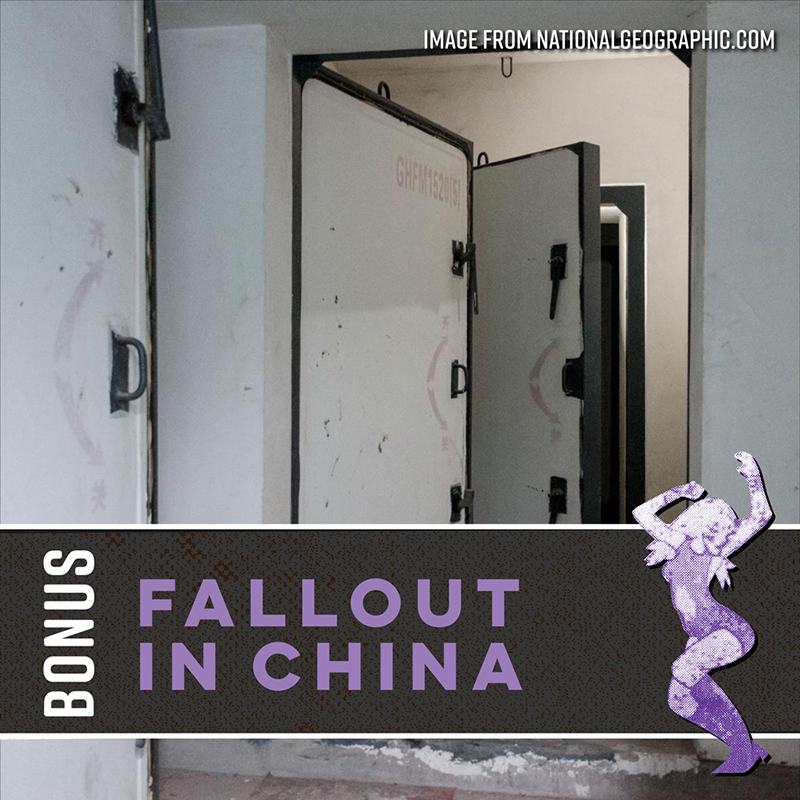
Wednesday Mar 07, 2018
Bonus Episode: Fallout In China
Wednesday Mar 07, 2018
Wednesday Mar 07, 2018
After Rebecca told the story of the USA's most famous fallout shelter, Caitlin wanted to dig up what these shelters looked like on her side of the world. This bonus episode tells you about what fallout shelters are like in Shanghai and a particular fascinating one in Beijing that's basically the size of a city.
For the full list of bonus episodes, visit memphistypehistory.com/bonus
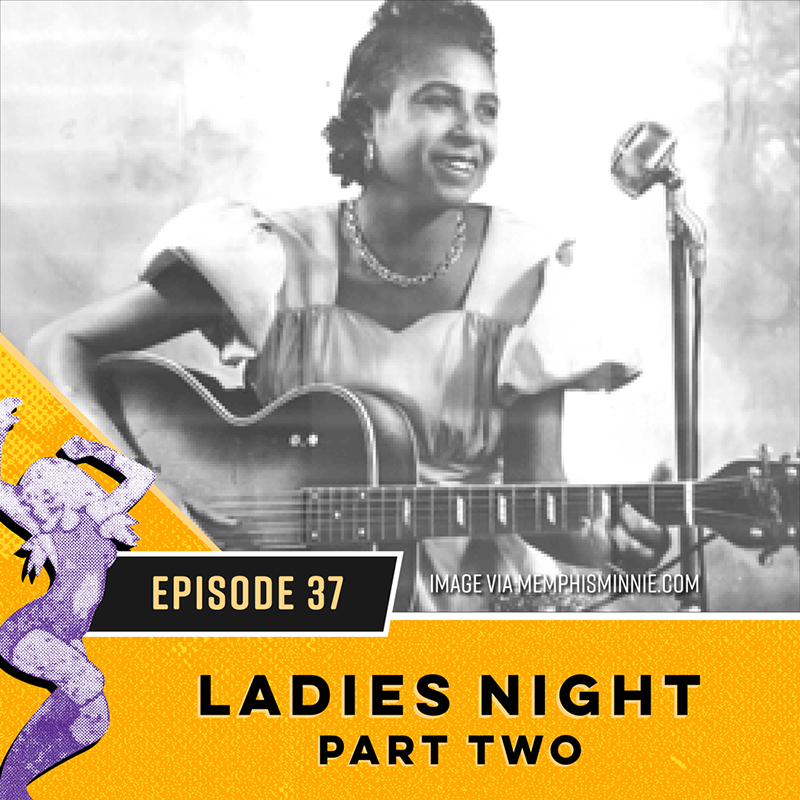
Monday Feb 26, 2018
Ladies Night Part Two
Monday Feb 26, 2018
Monday Feb 26, 2018
In this episode of Memphis Type History: The Podcast, Caitlin and Rebecca each pick a new favorite lady who left an impact in Memphis history to talk about. Turns out, they both picked musicians!
Elizabeth Lizzie Douglas (aka Memphis Minnie)
First up, Caitlin tells us about Elizabeth Lizzie Douglas (who we refer to as Minnie), a blues guitarist, vocalist, and songwriter, recording about 200 songs from the 20s to the 50s. People claim she was the most popular female country blues singer of all time, comparable to any man musician of the time. Elizabeth was born in 1897 in Algiers Lousiana, and moved to Walls, Mississippi with her family when she was seven years old. The next year she was gifted a guitar and by ten years old learned to play the banjo and began performing with her guitar, as "Kid Douglas" at parties.
In 1910 when she was 13 she went off to live on Beale Street, playing on street corners, staying with the folks when she was short on cash. There, she partnered up with Willie Brown, who is most famous with working with Charlie Patton. They headed to Bedford, Mississippi, a place that we assume to be well known for tourism in the time.
Next, Minnie joins the circus! The Ringling Bros. Circus 1916-1920 to be exact. But 1920 she returns to Beale Street, to perform on the streets again. It's believed she married her first husband Will Weldon in the early 20s as well. More well known was her second husband, Wilbur Kansas Joe McCoy, a blues singer from Mississippi. In 1929 a Columbia Records scout discovered them while they were out performing for dimes. They went of to New York City where the nicknames, Memphis Minnie and Kansas Joe became established. They played duets together, playing well known songs such as "Bumble Bee."
Minnie was super independent and elegant, chewing tobacco while singing and not missing a beat. By the 1930s, Minnie was very successful, went on tours and met her third husband, Little Son Joe, and began recording with him. When 1941 came, she picked up the electric guitar, and received her first hit "Me and My Chauffer Blues." Unfortunately, she didn't keep up with the trends of the late 40s and was dropped from the record labels.
Caitlin then goes over the end days of her life, she was one of the first 20 artists to be inducted in the blues foundation hall of fame, and Bonnie Rait paid for her headstone. Listen to the episode to hear what she had written on it.
Julia Ann Amanda Moorehead Britton
Next up, Rebecca talks about another famous musician Julia Britton, later known as Julia Britton Hooks. Julia was born in 1852 from freed African American parents in Kentucky. Her mother, Laura Marshall, was the daughter of Thomas F. Marshall, the Kentucky Statesman. She was also a well-educated and well-known singer and musician. This gift of musical talent was passed down to Julia. In fact, Julia was recognized a music prodigy, performing some of the most complex piano pieces.
We discover that this family was overall well respected. Julia's younger sister became the first African-American physician in Kentucky, her brother was a famous jockey, and Julia, at 18, enrolled at Berea College, making her one of the fist women of any race to attend college in the state of Kentucky.
How Julia Came to Memphis
In 1872 Julia moved to Greenville, Mississippi. She taught school and soon met and married Sam Wertles but lost him the following year to Yellow Fever. After his passing, she moved to Memphis in 1876. Memphis was the musicians paradise and this is where she came to be known as the "Angel of Beale St."
Memphis is also where she met and married Charles Hooks, and it was a city they both greatly invested in. Julia was not hesitant to actively protest against racism and inequality, leading her to occasionally get arrested and fined. On occasion was in 1881 when she was arrested at a Memphis theater for sitting at the "white balcony" and refusing to move to the "colored balcony".
Some of Julia's Greatest Contributions
In 1883, Julia and Anna Church opened the Liszt-Mullard Club to create opportunities in education for the black youth of the South. With the creation of this club, she was able to raise money to provide musically gifted black students to study music on a scholarship.
In 1891 she founded and became a charter member of the Orphans and Old Folks Home Club on Hernando Street where she'd purchased 25 acres. Three years later she had raised enough money giving concerts to pay off that debt. The purpose of the organization was to provide accommodations for orphans and elderly African-American women.
In 1892, Julia founded the Hooks School of Music and the Hooks Cottage School in response to the poor public education that black youth received in Memphis. The Hooks School of Music produced distinguished student musicians such as Sidney Woodward, Nell Hunter, and W.C. Handy.
For full show notes go to memphistypehistory.com/ladies2
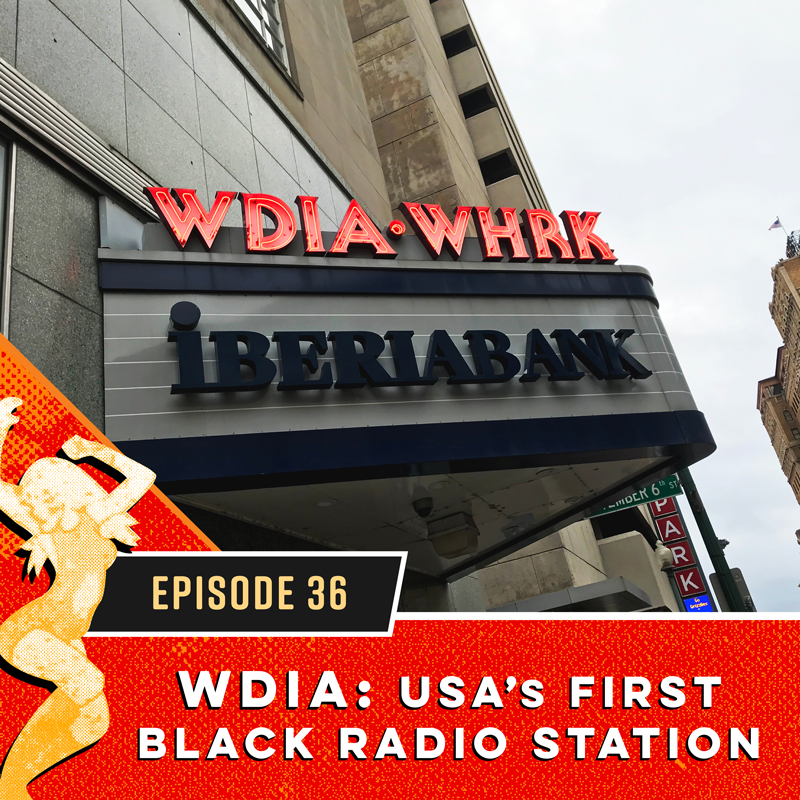
Monday Feb 19, 2018
WDIA: USA's First Black Radio Station
Monday Feb 19, 2018
Monday Feb 19, 2018
In this episode of Memphis Type History: The Podcast, Caitlin talks about WDIA, the first all-Black radio station in the U.S.A. We learn about how the transformation of this station into all-black programming and on-air talent exposed some of the best local talent to become major music icons we recognize today.
On June 7, 1947, WDIA transmitted onto the radio waves for the first time from its 2074 Union Avenue studio... one of just six Memphis radio stations at that time! Owned by John Pepper and Bert Ferguson, two white guys, the station played pop and country western music… and it headed towards bankruptcy very quickly. However, in October of 1948, they hired high school teacher and columnist Nat D. Williams, who started the first radio show for black listeners in the country on WDIA and saved the station.
Williams' show, Tan Town Jubilee, catapulted WDIA to 2nd most popular radio station in Memphis. The station then became the TOP station in Memphis after switching to all-black programming and all-black on-air talent. In 1954, the station increased to 50,000 watts, which meant it reached into the MS Delta, a bit of Missouri, and down to the Gulf Coast… which reached the ears of 10% of the black population in the US at that time. The station would go on to be known as the Starmaker Station because of the amount of exposure it provided local talent.
One thing that was really instrumental in the station’s success was that Williams was friends with Rufus Thomas, and got him onto the station… Thomas actually kept up his show until his death in 2001. Their ties to Beale Street got BB King’s career off to a start on the station as well as many other musicians. After Beale began declining, WDIA was really a big source of musical influence (even inspiring good ol’ Elvis Presley).
Another famous show on the station was called Goodwill. It covered civic news, missing children announcements, and raised money for community projects like scholarships, a bus for disabled kids, little league teams, and an orphanage, to name a few. The show turned into big fundraisers hosted by the WDIA DJ’s called the Goodwill Revue and the Starlight Revue. Big time local and national musicians like BB King, Rufus Thomas, Bobby “Blue” Bland, the Spirit of Memphis, Elvis, Sam Cooke, Muddy Waters, and Ray Charles performed for free. The local black community received about $100,000 a year from all of the Goodwill efforts.
Even though black talent and programming made WDIA so popular, and the staff was integrated in 1950 (rare for the South), it wasn’t until 1972 that Chuck Scruggs became the first black general manager and vice president. Under his 12-year service, the station helped raise money to preserve the Lorraine Motel and create the National Civil Rights Museum, and participated in the revitalization of Beale Street and the creation of the Stax Museum.
For full show notes go to memphistypehistory.com/WDIA
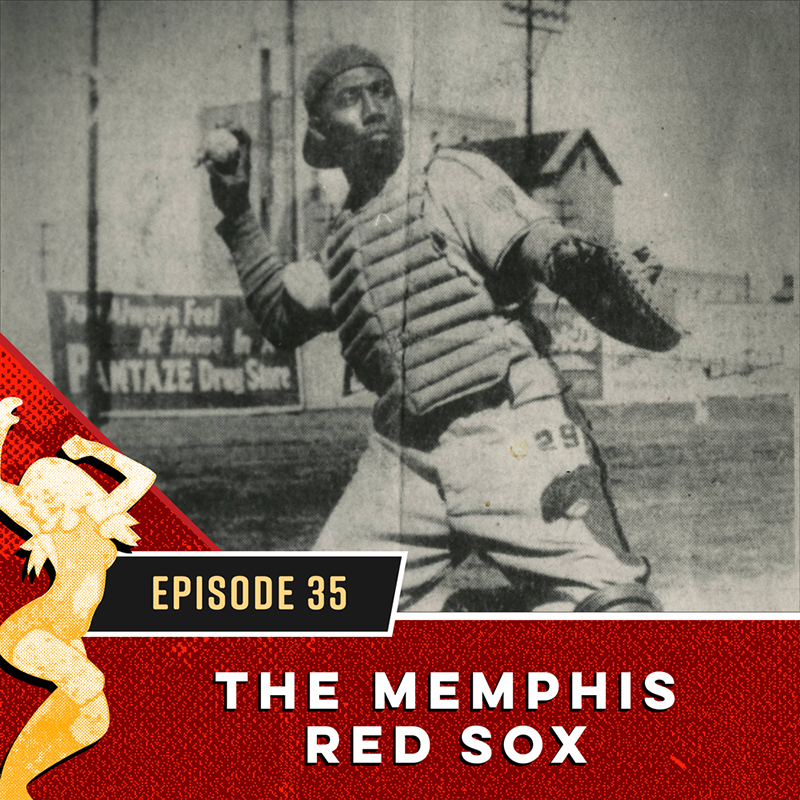
Sunday Feb 11, 2018
The Memphis Red Sox
Sunday Feb 11, 2018
Sunday Feb 11, 2018
In this episode of Memphis Type History: The Podcast, Caitlin talks about the Memphis Red Sox and you'll get to hear our best sports announcer voices as we talk about the prominence of the team in the city and it's eventual decline.
The Negro League Comes to Memphis
The negro leagues had been around for a long time before a team ever started playing in Memphis. Oftentimes, those teams became some of the strongest black owned businesses in the communities in which they operated. This business began to end when Jackie Robinson began playing in the white major leagues in 1945.
For more details about the league generally, look for some more details in the links section at the bottom.
There was a black team as early as the early 1900's. Lewis park was built, where the Red Sox played, in the 1920's. It was the first black ball park in America. The owner also owned R.S. Lewis & Sons funeral home with a long tradition of caring for well-known members of the black community at their passing, including Dr. Martin Luther King, Jr. after he was assassinated. Four brothers bought the stadium and the Red Sox. They were all successful business owners. The team was particularly profitable and well run... listen to the full podcast to find out how the Memphis ownership group was able to do so much better than many other teams.
The Memphis Red Sox
The team played in various leagues throughout the time it existed. They were only considered a "major league" team for just one of those years. In 1938 was the team's most successful season. They played for the championship but while being 2 up in the series, it was canceled because of business conflicts with the other team, the Atlanta Black Crackers. The Red Sox never played for the title again.
One of the brothers in the ownership group was run out of town for speaking up against Boss Crump and ended up going to Chicago where he owned another negro league team before eventually becoming the head of the negro league itself.
The End of the Negro Leagues
The Negro leagues created spaces for the black community to use for many other gatherings, a social connection point, and they were often some of the most successful businesses in their communities and the country. However, that success began to falter after integration. With many of the best players going to "the majors" tickets began to slide and eventually, the negro leagues would come to an end.
For full show notes visit memphistypehistory.com/sox
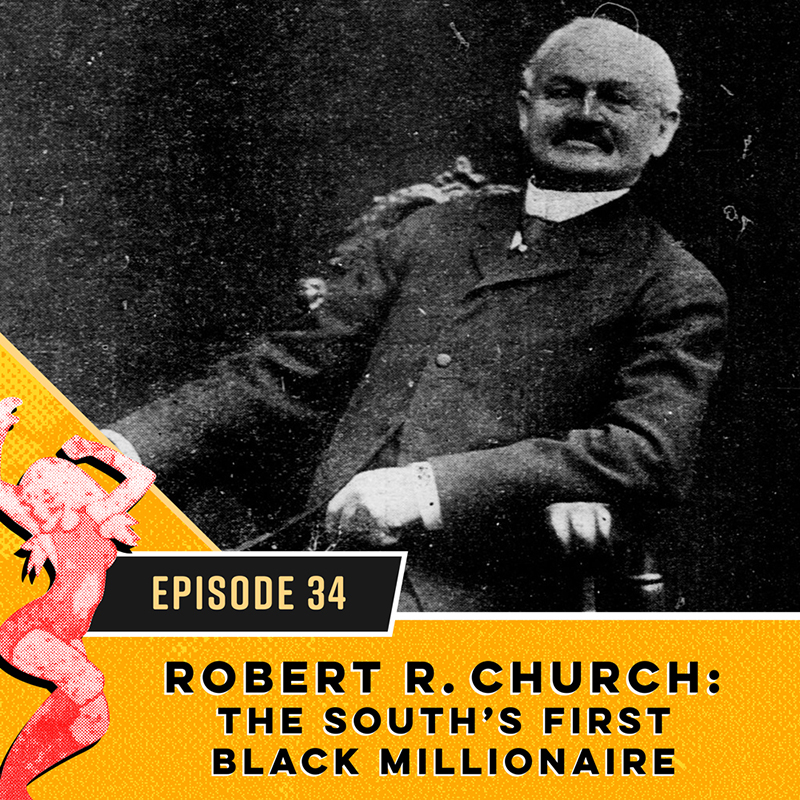
Monday Feb 05, 2018
Robert Church: The South's First Black Millionaire
Monday Feb 05, 2018
Monday Feb 05, 2018
This week, Caitlin and Rebecca start a new series for Black History Month. In this episode of Memphis Type History: The Podcast, Rebecca talks about a particular man who invested so much in Memphis, not only did he become recognized as the south's first African-American millionaire, but Memphis certainly wouldn't be the city it is today without him.
Robert Reed Church was born in Holly Springs Mississippi in 1939. His father, Charles B. Church, was a white steamboat owner-captain and his mother was one of his father's slaves. She died when Robert was only 12 years old.
Robert's father didn't treat him and his mother like slaves, yet he still didn't educate his son or ever formally recognize the relationship. His father did however train him in the steamboat business. Robert worked as a dishwasher, a cook, and a steward, which was the highest position for a black person.
In 1855, one of their luxury steamers caught fire and sank, though Robert and his father managed to survive. Then eventually, at age 23 while working as a steward on a boat, Robert gets dropped off in Memphis because the boat was captured by the Union Army.
Robert Church established himself as a successful Memphis businessman, owning a saloon, hotel, bank, restaurant and others that get discussed.
What we gather is, Church was invested in Memphis. And getting shot by a white mob and later on by a sheriff was not enough to make him leave the city.. nor was the Yellow Fever. In fact, he found that time as an opportunity to buy up real-estate when the property values were low. And when the time came that Memphis was reduced to a Taxing District, Church was the first citizen to buy a bond for $1,000, to restore the City Charter.
Rebecca then talks to Caitlin about some of her favorite Robert Church landmarks. The first is a hotel he owned in downtown Memphis on the southwest corner of South Second and Gayoso Streets. It was furnished with the best equipment of its day and advertised as the only first-class colored hotel in the city.
Another is the home he built for him and his family in the 1800s pictured above. It had 14 rooms, including a double drawing room (something that Caitlin and Rebecca try to guess is). The home was one of the first of the Queen Anne style built in Memphis. Unfortunately it does not still exist today.
Robert Church also founded the Solvent Savings Bank and Trust Company, the first black owned and operated bank in Memphis.
Rebecca's personal favorite establishment of his is the Church Park and Auditorium that also does not exist today other than the landmark that is pictured above. In 1899, Memphis lacked public parks for black citizens so Church bought a tract of land on Beale St., and built an auditorium which seated 2 thousand people. It was a cultural, recreational, and civic center for African-Americans and the only of its kind in the U.S. owned and operated by a person of color for members of his race.
Fun fact: W.C. Handy was employed as the orchestra leader for the park and auditorium.
For full show notes, visit memphistypehistory.com/millionaire
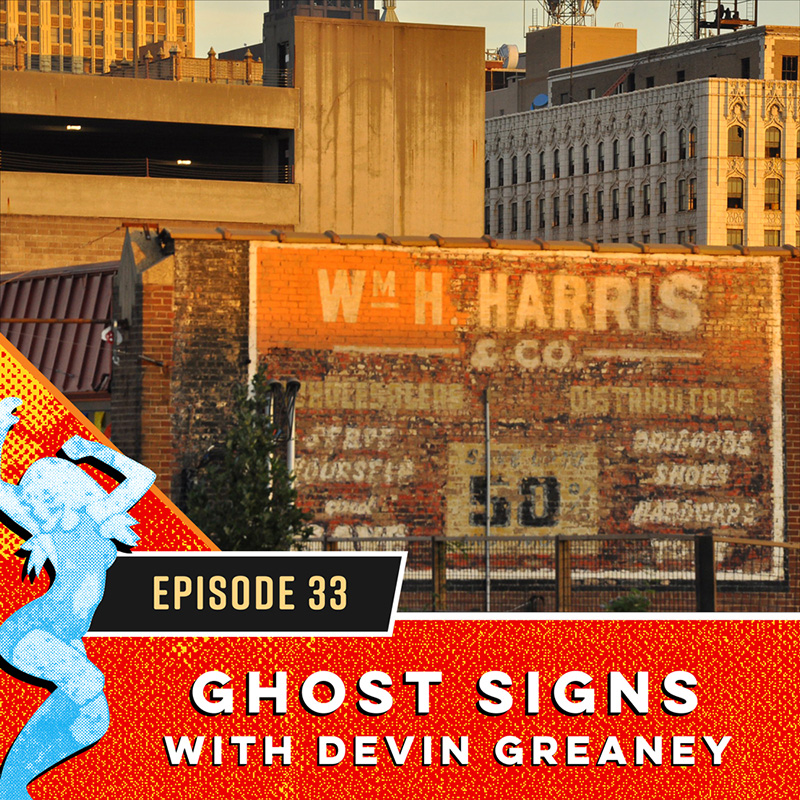
Monday Jan 29, 2018
Ghost Signs with Devin Greaney
Monday Jan 29, 2018
Monday Jan 29, 2018
In this episode of Memphis Type History: The Podcast, Caitlin chats wtih Devin Greaney, Memphis’ very own ghost sign hunter. Sit back and relax because after this episode you’ll want to look up a bit more when you’re out and about! A ghost sign is a sign or ad created many years ago that no longer serves a purpose. Sometimes they peek out from renovated buildings, or can be found on the peeling paint of an exterior wall. In Memphis, we pass by many of these… and these are their stories.
Devin introduces himself as a freelance writer and photographer. He likes writing about a variety of topics including old Memphis in particular. And then jumps into exactly what is a ghost sign because really.. why is it called a ghost sign?
Whether a sign that was covered by a newer building or one that is faded, these ghost signs are signs or ads that were created many years ago and don’t serve a purpose other than peek the interests of a passerby. In Memphis, we pass by many of these. For Devin, he likes to dig into the history of these signs for local history and the story behind them. In particular, he recalls an old Dr. Pepper sign that was uncovered when a building was knocked down in ’86 on Evergreen and Poplar.
What would making a sign from that time look like? In the past, there weren’t as many sign ordinances as there are now so there was less restriction on size and colors. What wasn’t uncommon was finding a few trends through the decades on these signs based on the types of fonts used and colors. However, the best way to date these signs is to look into the history of the building they belonged to and the businesses it housed.
Devin has researched many ghost sign such as Hotel Pontotoc, the Lamar Theater (hear a bit of a rumor on this landmark in this episode), and a sign for a beauty school downtown which also has a rumor that Devin talks about.
Caitlin asks which are the favorites uncovered and Devin says one in particular is Goodman and Son Jewelers which closed in 1989. Located between BB. King and Second Street it had opened in 1862. He also talks about several others, including a Bassoon shop (how often do you come across a bassoon shop?), a Firestone smokestack which Devin compares to what FedEx is to us now.
Though Elvis doesn’t make an appearance on this episode, we learn about how Memphis didn’t become the tourist destination that we know of it today until 1982 when Graceland opened for tours. Devin also gives us an insight into how the Heartbreak Hotel came to life in March of 83′ and how it was originally called the King’s Heartbreak Hotel and replaced a different old motel. The old painted, faded sign can still be found on the building.
One sign that was able to surprise Devin was the Hickman building on 248 Madison, across the street from the YMCA. It closed in 1971 was almost lost in in 1993 fire, and in 2017 began remodeling. It’s fascinating to think about the chapters of a buildings life and how far they survive. Devin also points out one of the unique characteristics of Memphis is that this city still holds a lot of natives that can remember significant events that occurred throughout the city, whereas in other big cities where many occupants are transplants, people can’t relate to things that have happened in years past.
If there’s anything you should gather from this episode, it’s that we shouldn’t keep things from the past just for the sake that they’re old. If they don’t serve a purpose, or are an eye sore, what is the point? Some things are better left re-purposed, like Beale Street when it revamped in 1983. People made comments about how it wasn’t the same Beale Street from the 30s but it really can’t survive to live like the 30s. At some point, we need to think practically about what parts of historic properties remain. Crosstown Concourse is a good example of this.
What other types of stories does Devin have to share about the uniqueness of this city? There’s a spot on the floor that is damaged and the Broom Closet, located in South Main. Story goes, in 1918, officer, Edward Broadfoot goes in to investigate something and was shot down in the store. The blood soaked the ground and that spot remains on that floor. Devin also talks about other historical markers with stories many are unaware of. It’s a good list, so make sure you take a listen. However, there is ONE historical marker that Devin does NOT approve for a reason that you probably wouldn’t guess.

Monday Jan 22, 2018
Surviving the Bomb: Memphis' Famous Fallout Shelter
Monday Jan 22, 2018
Monday Jan 22, 2018
In this episode of Memphis Type History: The Podcast, we talk about something that has come up more lately than many of us would've expected: fallout shelters. Learn about Memphis' history of one particular famous safe place and how it drew criticism from the state controlled press in Russia at the time.
It was a time of terror and wonder. No, we're not talking about a few weeks ago when that accidental message made Hawaiians think a bomb was heading for them... we are talking about the Atomic Age when the Soviet Union was talking about building a bigger and better bomb to compete with the U.S. Meanwhile, the U.S. had picked a spot in a desert not too far from Las Vegas to test our own nukes. From 1951-1992 there were a total of 928 explosions at the site. 100 above ground tests of these nuclear bombs happened between 1951 to 1962.
This was a pretty big deal for Las Vegas because of the tourist attraction it became. People could watch the mushroom clouds blossom in the distance. Casinos offered mushroom cloud souvenirs, atomic cocktails, and the Miss Atom Bomb beauty pageant.
So what would Caitlin do if there was a real bomb threat? You'll have to listen to find out.. but Rebecca does give her a brief history on the plans Memphis had during the Atomic Age, should a bomb threat arise.
In the 1950s, the goverment printed millions of bright yellow pamphlets called, "Be Safe from the H-Bomb." These were inserted in copies of The Commercial Appeal and Memphis Press-Scimitar. All it basically said was to get out of the city quickly. Even with a two-hour notice of a bomb arriving (which is about the time they were able to give) this seemed like an impractical plan to have everybody try to pack up and leave the city in that time span.
So a new plan was developed to take shelter instead of run away. Memphis set up 279 shelters with 251 of them fully stocked with food. Special sanitation kits, water, toilet paper and other necessities were provided but not beds, chairs, or cots. And the instruction was to walk to one of these shelters, not drive.
One particular shelter has a quite a story. It was a built by Hoyt B. Wooten who full-filled his boyhood dream by building one of these in his backyard.
Hoyt B. Wooten was the owner of the radio station WREC, member of the Kiwanis Club and director of the National Association of Regional Broadcasting Stations in the U.S. In 1958 he paid $12,000 for 27 acres to build a home in Whitehaven on Highway 51. The house was built in 1962 at a cost between $150,000-$200,000.
He then designed and engineered the equipment of a shelter that was 5,600 sq. ft., made to house 56 people for up to 31 days following a nuclear blast. The ceilings were 9.5 feet high with foot thick steel enforced concrete. Wooten believed it would take a 20-megaton bomb falling eight miles away to disturb them.
The shelter had its own electrical supply, its own water supply (Water came from wells 93 feet below the ground. There was even a pumping system in case of flooding), its own air purification system (Wooten used this to pump Chanel No. 5 for his kids' events), a library with a collection of books, current periodicals such as LIFE and TIME Magazines, and Wooten's collection of National Geographic.
One Commercial Appeal article goes into even greater detail...
"There was a film library, a pool table, Ping Pong table and a dart board. There was a kitchen to prepare meals for all the guests and pantries to store food for the duration of the 31-day cooling off period.
The guests would be housed in dormitories with bunk beds, separate restrooms for men and women, and sliding panels in the dormitories to provide some separation for different age groups."
The heart of the shelter was a communications system including AM and FM radio receivers, a remote control TV set, a movie screen with 25 feature films, and telephones.
The shelter was lit by custom built fixtures with multiple switches. My personal favorite is the lighting in the kitchen window to give the ambience of daylight. If all the main lights were turned off, dim 7.5-watt bulbs automatically turned on so the rooms would never be completely dark. And then they also had candles in brackets along the walls in case of a black out.
In conclusion, this was not your average fallout shelter. In fact, it was so well publicized that it drew criticism from the state controlled press in Russia at the time. Perhaps they were upset because they want to break us. (Don't know that quote? Find it in this U.S. Cold War propaganda film from the 80's)
For full show notes go to memphistypehistory.com/fallout
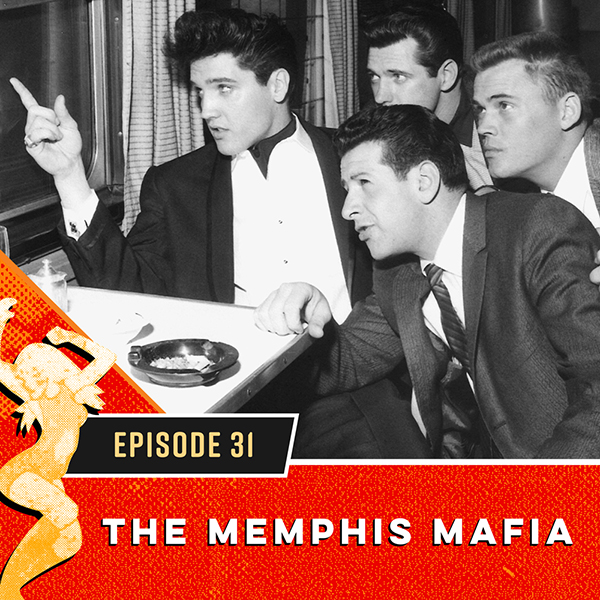
Sunday Jan 14, 2018
The Memphis Mafia
Sunday Jan 14, 2018
Sunday Jan 14, 2018
For full show notes go to memphistypehistory.com/mafia
